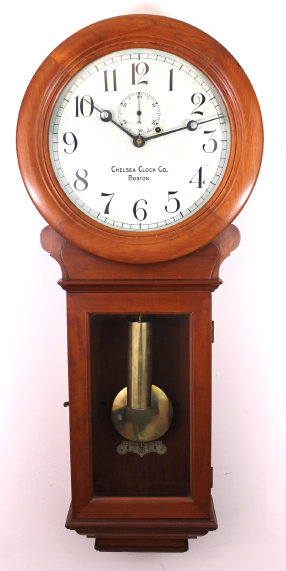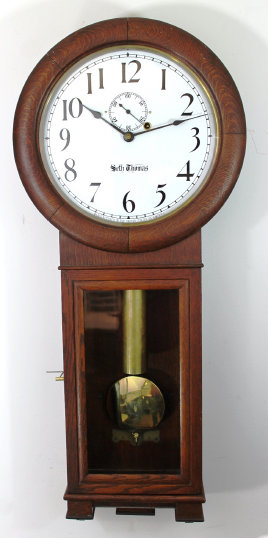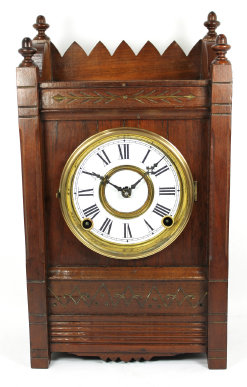
328. $1800
Chelsea Clock Co. “Regulator No. 3”, 1900-1904. An uncommon clock, all the more so when found
in cherry, as here. The clock is 37 inches long with a 12-inch dial and was designed to compete with the Seth Thomas No. 2 regulator,
with the weight falling in front of the pendulum. It differs from the more common Chelsea No. 1 Pendulum where the flat
weight falls behind a weight shield. The movement is numbered 86292, dating its manufacture to between 1900 and 1904. It is running and keeping time. Both glasses are old; the metal dial was probably repainted some time ago, and some chipping
has been touched up at the winding port. The case has been thoroughly cleaned if not refinished. A single comparable sale
in the Antique Clocks Price Guide: a cherry-case model sold at Schmitt’s in 2012 for $4900. $3000-$5000.


329. $550
Seth Thomas Regulator No. 2, ca. 1900. An oak case with an old finish, nicely aged. Lower
glass old, dial glass newer. The dial has been repainted. Hands are correct, pendulum bob bright and shiny, with a new
pendulum stick. Old weight and old beat scale. The signed movement is running and keeping time. No label. $800-$1200.
330. $85
Atkins Octagon Top, 1859-1879. A 10.25-inch case with good rosewood veneer all around, two old
glasses and a nice Atkins-style gold stencil backed in black. Just a 30-hour movement, time only but with an alarm that winds
separately (the winding port is at the upper left and visible only with the door open). Hands aren’t exactly correct, but will
do; door latch is non-functional. Good label from Bristol. Running and keeping time, if you don’t mind winding it every
day. $85-$120.


332. $100
F. Kroeber “Cabinet No. 51”, ca. 1888. One of many cabinet clocks marketed by Kroeber in New
York in the late 1800’s. This one can be found on page 138 of Ly’s book on Kroeber clocks. It stands 14 inches high and
has a 4-inch chapter ring on a new paper dial. The bezel is shiny brass with an old flat glass. The case is walnut with
a mahogany color and looks to be the original finish, cleaned and waxed. You can even see the gold paint in the incising on
the front. The signed 8-day movement is dirty but is running and keeping time. It strikes a Kroeber wire gong on the hour
and half-hour. No sales records that we can find; we estimate $125-$225.

331. $100
J. C. Brown Cottage, ca. 1850. The refinished rosewood case is 14.75 inches high; the
veneer is in good shape with some lifting on the right side where it appears that heat damage to the back occurred. If there
was ever any gold stenciling on the case itself there is no sign of it now. There is a chip at the top right corner. The
upper glass has a crack running across it which is not visible except at certain angles, and there seems to be a coating over the
entire glass from the inside, perhaps to seal the crack and stabilize the glass. The typical gold stencil on this glass is nearly
complete; sometimes you see this backed in black, but not always. The lower cut and frosted glass is old (there is a large bubble
on the right side) and usually is suggested to not be original, as these clocks often had a reverse-painted scene or image of Brown,
but there are several examples of this clock with a frosted lower glass. The door handle is original ivory/bone. The signed
dial has been repainted, the hands correct and probably original. The eight-day time-and-strike movement is signed Forestville
Manufacturing and is running and striking as expected. There is a nice green label inside. These clocks are not uncommon but
remain popular and vary widely in price. $100-$250.


333. $150
Chauncey Jerome “Column & Cornice”, 1845-1855. A 26.5-inch case with good mahogany veneer,
a few chips along the base and the center section of the segment between the upper and lower door having been replaced. No doubt
the entire case has been refinished, and the columns originally may have been gold leaf or black, or a combination of both. The upper and lower tablets are the main attractions here – original and in outstanding condition; the dial glass is old as well. The metal dial has been touched up but looks good and there is about half of a label inside, clearly indicating a Jerome case manufactured
in New Haven with a label printed by Benham in New Haven. The 30-hour weight-driven brass movement is also signed by Jerome
and was made in Bristol, dating it to before the fire that destroyed his Bristol factory in 1845. The clock is running and striking
as required. $200-$325.